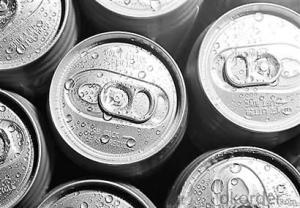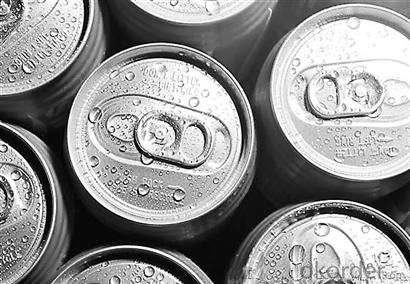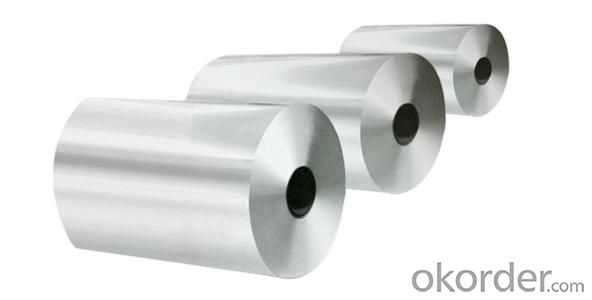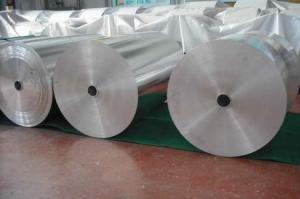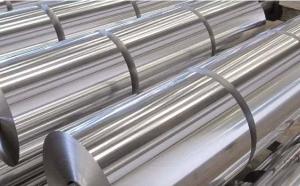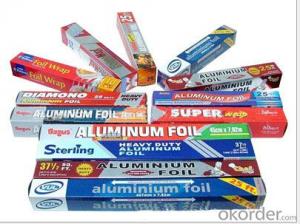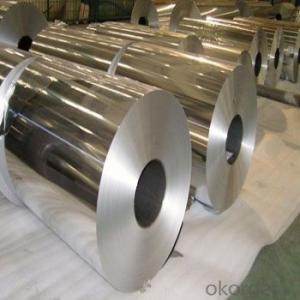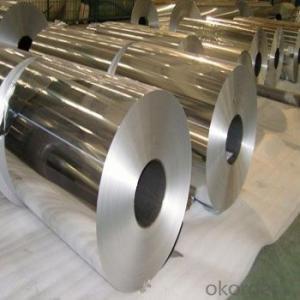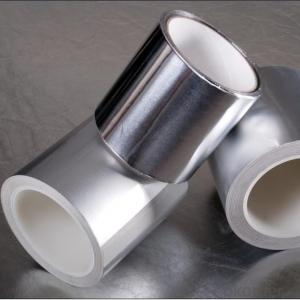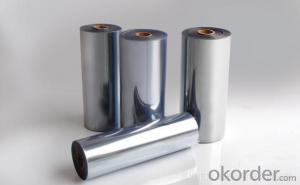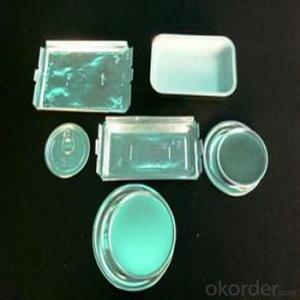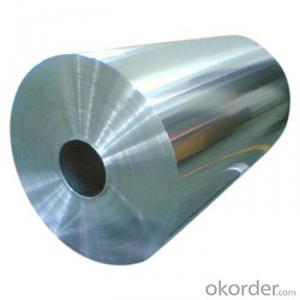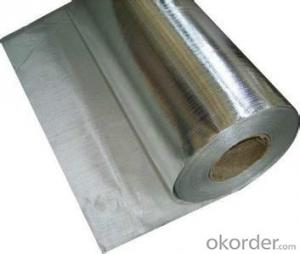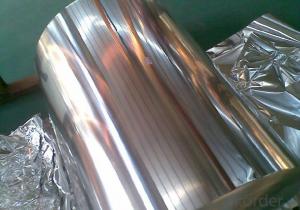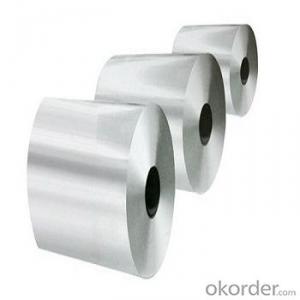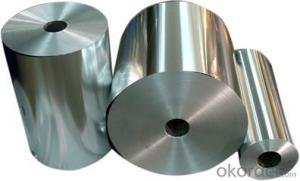Cigarette Aluminum Foil Paper for Can Stock
- Loading Port:
- China Main Port
- Payment Terms:
- TT or LC
- Min Order Qty:
- -
- Supply Capability:
- -
OKorder Service Pledge
OKorder Financial Service
You Might Also Like
Aluminium alloys with a wide range of properties are used in engineering structures. Alloy systems are classified by a number system (ANSI) or by names indicating their main alloying constituents (DIN and ISO).
The strength and durability of aluminium alloys vary widely, not only as a result of the components of the specific alloy, but also as a result of heat treatments and manufacturing processes. A lack of knowledge of these aspects has from time to time led to improperly designed structures and gained aluminium a bad reputation.
One important structural limitation of aluminium alloys is their fatigue strength. Unlike steels, aluminium alloys have no well-defined fatigue limit, meaning that fatigue failure eventually occurs, under even very small cyclic loadings. This implies that engineers must assess these loads and design for a fixed life rather than an infinite life.
Another important property of aluminium alloys is their sensitivity to heat. Workshop procedures involving heating are complicated by the fact that aluminium, unlike steel, melts without first glowing red. Forming operations where a blow torch is used therefore require some expertise, since no visual signs reveal how close the material is to melting. Aluminium alloys, like all structural alloys, also are subject to internal stresses following heating operations such as welding and casting. The problem with aluminium alloys in this regard is their low melting point, which make them more susceptible to distortions from thermally induced stress relief. Controlled stress relief can be done during manufacturing by heat-treating the parts in an oven, followed by gradual cooling—in effect annealing the stresses.
The low melting point of aluminium alloys has not precluded their use in rocketry; even for use in constructing combustion chambers where gases can reach 3500 K. The Agena upper stage engine used a regeneratively cooled aluminium design for some parts of the nozzle, including the thermally critical throat region.
Another alloy of some value is aluminium bronze (Cu-Al alloy).
Aluminium foil acts as a total barrier to light and oxygen (which cause fats to oxidise or become rancid), odours and flavours, moistness, and germs, it is used broadly in food and pharmaceutical packaging. The purpose of aluminium is to make long-life packs (aseptic processing|aseptic packaging) for drinks and dairy goods, which allows storing without refrigeration. Aluminium foil containers and trays are used to bake pies and to pack takeaway meals, ready snacks and long life pet foods.
Aluminium foil is widely sold into the consumer market, often in rolls of 500 mm (20 in) width and several metres in length.It is used for wrapping food in order to preserve it, for example, when storing leftover food in a refrigerator (where it serves the additional purpose of preventing odour exchange), when taking sandwiches on a journey, or when selling some kinds of take-away or fast food. Tex-Mex restaurants in the United States, for example, typically provide take-away burritos wrapped in aluminium foil.
Aluminium foils thicker than 25 μm (1 mil) are impermeable to oxygen and water. Foils thinner than this become slightly permeable due to minute pinholes caused by the production process.
Aluminium foil has a shiny side and a matte side. The shiny side is produced when the aluminium is rolled during the final pass. It is difficult to produce rollers with a gap fine enough to cope with the foil gauge, therefore, for the final pass, two sheets are rolled at the same time, doubling the thickness of the gauge at entry to the rollers. When the sheets are later separated, the inside surface is dull, and the outside surface is shiny. This difference in the finish has led to the perception that favouring a side has an effect when cooking. While many believe that the different properties keep heat out when wrapped with the shiny finish facing out, and keep heat in with the shiny finish facing inwards, the actual difference is imperceptible without instrumentation.The reflectivity of bright aluminium foil is 88% while dull embossed foil is about 80%.
We provide a full range of precision aluminum strip for almost any application. We produce aluminum strip in a wide variety of alloys, including clad composites. Our aluminum strip can be produced in standard dimensions or custom made to your special requirements. We produce both imperial and metric units. We manufacture in compliance with the main international specifications, and tighter tolerances or custom tempers are available upon request. We offer various surface conditions, custom finishes (painting, anodizing, embossing), special processing, and multiple packaging options to meet our customer's unique requirements. The following is a summary of our capabilities.
Manufactured in compliance with the main international specifications and standards, including: Aluminum Association, ASTM, EN, and DIN.
We can also manufacture in compliance with other international standards including:ASME, SAE, AMS, AWS, FED, MIL, QQ, ISO, BS, AFNOR, JIS and GOST.
Manufactured in compliance with the main international specifications and standards.
Tighter tolerances are available upon request.
Aluminium (or aluminum; see spelling differences) is a chemical element in the boron group with symbol Al and atomic number 13. It is a silvery white, soft, ductile metal. Aluminium is the third most abundant element (after oxygen and silicon), and the most abundant metal in the Earth's crust. It makes up about 8% by weight of the Earth's solid surface. Aluminium metal is so chemically reactive that native specimens are rare and limited to extreme reducing environments. Instead, it is found combined in over 270 different minerals.The chief ore of aluminium is bauxite.
Aluminium is remarkable for the metal's low density and for its ability to resist corrosion due to the phenomenon of passivation. Structural components made from aluminium and its alloys are vital to the aerospace industry and are important in other areas of transportation and structural materials. The most useful compounds of aluminium, at least on a weight basis, are the oxides and sulfates.
Despite its prevalence in the environment, no known form of life uses aluminium salts metabolically. In keeping with its pervasiveness, aluminium is well tolerated by plants and animals. Owing to their prevalence, potential beneficial (or otherwise) biological roles of aluminium compounds are of continuing interest.
The earliest citation given in the Oxford English Dictionary for any word used as a name for this element is alumium, which British chemist and inventor Humphry Davy employed in 1808 for the metal he was trying to isolate electrolytically from the mineral alumina. The citation is from the journal Philosophical Transactions of the Royal Society of London: "Had I been so fortunate as to have obtained more certain evidences on this subject, and to have procured the metallic substances I was in search of, I should have proposed for them the names of silicium, alumium, zirconium, and glucium."
Davy settled on aluminum by the time he published his 1812 book Chemical Philosophy: "This substance appears to contain a peculiar metal, but as yet Aluminum has not been obtained in a perfectly free state, though alloys of it with other metalline substances have been procured sufficiently distinct to indicate the probable nature of alumina."[69] But the same year, an anonymous contributor to the Quarterly Review, a British political-literary journal, in a review of Davy's book, objected to aluminum and proposed the name aluminium, "for so we shall take the liberty of writing the word, in preference to aluminum, which has a less classical sound."
The -ium suffix conformed to the precedent set in other newly discovered elements of the time: potassium, sodium, magnesium, calcium, and strontium (all of which Davy isolated himself). Nevertheless, -um spellings for elements were not unknown at the time, as for example platinum, known to Europeans since the 16th century, molybdenum, discovered in 1778, and tantalum, discovered in 1802. The -um suffix is consistent with the universal spelling alumina for the oxide (as opposed to aluminia), as lanthana is the oxide of lanthanum, and magnesia, ceria, and thoria are the oxides of magnesium, cerium, and thorium respectively.
The aluminum spelling is used in the Webster's Dictionary of 1828. In his advertising handbill for his new electrolytic method of producing the metal in 1892, Charles Martin Hall used the -um spelling, despite his constant use of the -ium spelling in all the patents[58] he filed between 1886 and 1903. It has consequently been suggested[by whom?] that the spelling reflects an easier-to-pronounce word with one fewer syllable, or that the spelling on the flyer was a mistake.[citation needed] Hall's domination of production of the metal ensured that aluminum became the standard English spelling in North America
- Q: I have this question and I don't know how to figure it out:Determine the number of protons, neutrons,and electrons in an atom of aluminum-27? any help please? or do you know how to figure this out?
- Al 27 in an isotopeIsotopes have the same number of protons, but different numbers of neutronsatomic number number of protons Aluminum's atomic number is 13 27 - 13 14 neutrons protons: 13 neutrons: 14 electrons: 13
- Q: I use sheets, but I am thinking to upgrading to blinds after all those years.
- When I used to work nights, I actually covered them with aluminum foil, so I could sleep during the day-
- Q: what will happen if i rub a balloon against my clothes or wool then put them near these materials:saltaluminum foilwheatcerealtissue paperWhats there reactions and why does it happen?
- (L) EASY BAKED PORK CHOPS WITH STUFFING 6 lean pork chops (may use 4 or 5) 1 box Stove Top pork stuffing mix 1 can cream of mushroom soup Line 13 x 9 inch pan with aluminum foil on bottom and sidesHeat oven to 300 degreesMake stuffing according to directions on boxBrown pork chops and arrange in bottom of panTop each pork chop with equally divided dressingSpoon undiluted soup on top of dressing and chopsCover pan completely with foil and seal edgesBake at 300 degrees for 2 to 2 1/2 hours.
- Q: I've Filled to cups up with about 250/300ml tap water each and put 3ish grams NaCl in both! I'v put citric acid (from lemon juice thing) about 20ish ml in one cup and same amount of coke in other mug! Then I've riged a wire to 50p coin and put it in the lemon juice cup and at the other end of the wire i'v attached a 2p coin into the NaCl cola cup! Then I'v attched just a wire into the citric acid NaCl cup and the other end of the wire to a piece of iron (small spanner) and placed it ito the cola NaCl cup! Also i'v added aluminum foil in the citric acid side and a few pennies, the other mug i'v added few 5p's! I know this is.crude science but Is there a chance Cl2 gas will be released or would any chemical reaction take place? Due to the H+ ions? Or would anything happen? Any info would be great! (it is.just a.crude experiment) Thanks!
- Compass, Pencil, Scrabble.
- Q: Gregg hereI've heard numerous things about the standard (aluminum) AR-15 lower receivers being used for larger calibershow long will the lower last under that kind of stress? I mean, a .50 Beowolf is a rather powerful round, and I'm thinking, if it recoils as hard as it does (shot one magazine full.)Has anyone had problems with the lowers cracking/chipping (around any major quot;contactquot; points)? I'm really interested10 ptsto the most informational/educational answer.
- This is the best cheesecake recipe I've ever found, and I spent about 5 years experimenting! Feel free to add mini chocolate chips, and drizzle with caramel sauce! It's not totally necessary, but I find I get better results, when I wrap the outside of the pan with 2 layers of heavy duty foil, and put the cheesecake in a roasting pan with water around it (hot water bath)It makes the cheesecake cook more evenly without any crackingCheesecake INGREDIENTS: 1 1/2 cups graham cracker crumbs 1/2 cup white sugar 1/4 cup butter, melted 5 (8 ounce) packages cream cheese, softened 5 eggs 2 egg yolks 1 3/4 cups white sugar 1/8 cup all-purpose flour 1/4 cup heavy whipping cream DIRECTIONS: 1Preheat oven to 400 degrees F (200 degrees C)2Mix the graham cracker crumbs, 1/2 cup of the white sugar, and the melted butter togetherPress mixture into the bottom of one 9 or 10 inch springform pan3In a large bowl, combine cream cheese, eggs and egg yolks; mix until smoothAdd the remaining 1 3/4 cups white sugar, the flour and the heavy creamBlend until smoothPour batter into prepared pan4Bake at 400 degrees F (200 degrees C) for 10 minutes, then turn oven temperature down to 300 degrees F (100 degrees C) and continue baking for 1 hour, or until filling is setLet cheesecake cool, then refrigerate.
- Q: INGREDIENTS (Nutrition) 1 cup white sugar 3 eggs 1 (14 ounce) can sweetened condensed milk 1 (12 fluid ounce) can evaporated milk 1 tablespoon vanilla extract DIRECTIONS 1Preheat oven to 350 degrees F (175 degrees C) 2In a medium saucepan over medium-low heat, melt sugar until liquefied and golden in colorCarefully pour hot syrup into a 9 inch round glass baking dish, turning the dish to evenly coat the bottom and sidesSet aside 3In a large bowl, beat eggsBeat in condensed milk, evaporated milk and vanilla until smoothPour egg mixture into baking dishCover with aluminum foil 4Bake in preheated oven 60 minutesLet cool completely 5To serve, carefully invert on serving plate with edges when completely cool.
- During the cold winter months, it's probably fineBut unless you want your A/C to work overtime in the summer, fix it by SpringOh, and ralize it will allow bugs and critters to enter your house, as they can crawl up the outside exhaust and come into the ho use thru the hole in your pipeIf you have a cat, this probably won't be much of an issueMy dad once installed a flap thing on the dryer exhaust ventYou could open the flap and it would blow warm air into the room(winter mode)You coudl close the flap and send the hot air outside during summerI think that was a great idea.
- Q: hich of the following recycling operations (remaking from scrap) results in the biggest energy savings?
- Recycling aluminium saves 95% of the energy cost of processing new aluminiumThis is because the temperature necessary for melting recycled, nearly pure, aluminium is 600 °C, while to extract mined aluminium from its ore requires 900 °C.
- Q: 1Identify which of the following could produce current:aa wire connected across a battery's terminusbtwo electrons in a solution of positive and negative ions.ca salt crystal whose ions cannot move.da sugar water mixture.2Classify the following materials as conductors or insulators:?woodpaper clipglassair paperplasticsteelnailwateraluminum can3identity which of the following would have the strongest magnetic fieldAssume the current in each is the same.Aa straight wire.Ban electromagnet with 30 coils.Ca solenoid with 20 coils.Da solenoid with 30 coils.
- 1A 2wood - insulator paper clip - conductor glass - insulator air - insulator paper - insulator plastic - insulator steel - conductor nail - conductor water - conductor aluminum can - conductor 3B D are the same
- Q: This question asks about the distinctions among various types of aluminum foil, likely in terms of their properties, uses, or manufacturing processes.
- <p>Aluminum foil comes in different types, each with unique characteristics. Heavy-duty foil is thicker and more durable, ideal for grilling or roasting. Standard foil is thinner and commonly used for food storage or cooking. Reynolds Wrap Platinum is a premium foil with a non-stick surface, perfect for delicate foods. Oven-Ready foil is pre-cut and designed for easy use in the oven. Foil with a dull side is better for heat retention, while shiny side foil reflects heat. Additionally, some foils are treated with antimicrobial agents or are designed for specific uses like baking or cooking with microwaves. Each type is chosen based on the intended application, providing versatility in food preparation and storage.</p>
- Q: how do you make a turkey?
- You'll Need: A big roll of heavy duty aluminum foil A bulb baster (looks like a giant eye dropper) Time and patience Medium to large roasting pan depending on the size of the turkey1 cup of water A pair of oven mitts 1 can of turkey or chicken broth, any brand Stove set on bake and 350 degrees F How to Cook a Juicy Turkey: Step 1: Lay the turkey on a piece of tin foil big enough to go around it length wise as a way to measure the size neededStep 2: Set the turkey aside and remove a second piece of foil from the roll that is the same length as the first pieceStep 3: Lay one piece of the aluminum foil length wise in the pan and the other width wise, center both pieces as evenly as possible in the pan so that there is the same overlap on each end (or side)Step 4: Place the turkey in the pan and pour the water and broth in around it along with any seasonings you useStep 5: Bring the ends of the piece of aluminum foil going width wise together and roll them down, but no too tightlyRepeat with the foil going lengthwiseStep 6: Place the turkey into the oven and let it cook until a fork inserted into the breast penetrates and comes out of the breast and a leg easilyStep 7: Baste with a bulb baster frequently, at least every 45 minutesStep 8: Cooking time varies depending on the size of the turkey but it usually takes 3-4 hours totalTips Warnings: The tin foil holds in the heat and steam so that along with the water and chicken or turkey broth the turkey stays moistCooking the turkey on a lower heat for a longer period of time and basting often also helpsWhen cooking a roast you just leave out the tin foil, keep a lid on the meat, keep it covered with water and once again, cook slowly on 350 degrees FAlways wear the oven mitts when opening the foil to baste the turkey to avoid getting your hands burned by steam that is trapped inside.
Send your message to us
Cigarette Aluminum Foil Paper for Can Stock
- Loading Port:
- China Main Port
- Payment Terms:
- TT or LC
- Min Order Qty:
- -
- Supply Capability:
- -
OKorder Service Pledge
OKorder Financial Service
Similar products
Hot products
Hot Searches
Related keywords
